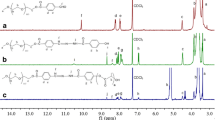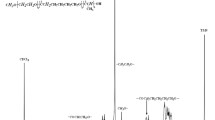Abstract
In this paper, novel biodegradable amphiphilic block-graft copolymers based on methoxy poly(ethylene glycol)-b-(polycarbonates-g-polycarbonates) (mPEG-b-(PATMC-g-PATMC)) were synthesized successfully for controlled release of doxorubicin (DOX). Backbone block copolymer, methoxy poly(ethylene glycol)-b-poly(5-allyloxy-1,3-dioxan-2-one) (mPEG-b-PATMC) was synthesized in bulk catalyzed by immobilized porcine pancreas lipase (IPPL). Then, mPEG-b-PATMC-O, the allyl epoxidation product of mPEG-b-PATMC, was further grafted by PATMC itself also using IPPL as the catalyst. The copolymers were characterized by 1N HMR and gel permeation chromatography results showed narrow molecular weight distributions. Stable micelle solutions could be prepared by dialysis method, while a monomodal and narrow size distribution could be obtained. Transmission electron microscopy (TEM) observation showed the micelles dispersed in spherical shape with nano-size before and after DOX loading. Compared with the block copolymers, the grafted structure could enhance the interaction of polymer chains with drug molecules and improve the drug-loading capacity and entrapment efficiency. Furthermore, the amphiphilic block-graft copolymers mPEG-b-(PATMC-g-PATMC) had low cytotoxicity and more sustained drug release behavior.







Similar content being viewed by others
References
Park JH, Lee S, Kim JH, Park K, Kim K, Kwon IC. Polymeric nanomedicine for cancer therapy. Prog Polym Sci. 2008;33(1):113–7.
Gemma V, Judit TP, Fernando F. Polymers and drug delivery systems. Curr Drug Deliv. 2012;9(4):367–94.
McKee MG, Unal S, Wilkes GL, Long TE. Branched polyesters: recent advances in synthesis and performance. Prog Polym Sci. 2005;30(5):507–39.
Zhang XJ, Chen FJ, Zhong ZL, Zhuo RX. Amphiphilic block-graft copolymers with a degradable backbone and polyethylene glycol pendant chains prepared via ring-opening polymerization of a macromonomer. Macromol Rapid Commun. 2010;31(24):2155–9.
Riess G. Micellization of block copolymers. Prog Polym Sci. 2003;28(7):1107–70.
Torchilin V. Tumor delivery of macromolecular drugs based on the EPR effect. Adv Drug Deliv Rev. 2011;63(3):131–5.
Lee JH, Lee HB, Andrade JD. Blood compatibility of polyethylene oxide surfaces. Prog Polym Sci. 1995;20(6):1043–79.
Molineux G. Pegylation: engineering improved pharmaceuticals for enhanced therapy. Cancer Treat Rev. 2002;28:13–6.
Otsuka H, Nagasaki Y, Kataoka K. PEGylated nanoparticles for biological and pharmaceutical applications. Adv Drug Deliv Rev. 2003;55(3):403–19.
Wang P, Tan KL, Kang ET. Surface modification of poly(tetrafluoroethylene) films via grafting of poly(ethylene glycol) for reduction in protein adsorption. J Biomater Sci Polym Ed. 2000;11(2):169–86.
Essa S, Rabanel JM, Hildgen P. Effect of aqueous solubility of grafted moiety on the physicochemical properties of poly(d, l-lactide) (PLA) based nanoparticles. Int J Pharm. 2010;388(1–2):263–73.
Qiu F, Feng J, Wu DQ, Zhang XZ, Zhuo RX. Nanosized micelles self-assembled from amphiphilic dextran-graft-methoxypolyethylene glycol/poly(ε-caprolactone) copolymers. Eur Polym J. 2009;45(4):1024–31.
Zhang XJ, Zhang ZG, Zhong ZL, Zhuo RX. Amphiphilic block-graft copolymers poly(ethylene glycol)-b-(polycarbonates-g-palmitate) prepared via the combination of ring-opening polymerization and click chemistry. J Polym Sci Part A. 2012;50(13):2687–96.
Feng J, Zhuo RX, Zhang XZ. Construction of functional aliphatic polycarbonates for biomedical applications. Prog Polym Sci. 2012;37(2):211–36.
Zheng XM, Jiang T, He F. Synthesis and characterization of PNIPAM-b-polycarbonate copolymers as self-assembled thermosensitive micelles for drug delivery. Acta Polym Sinica. 2011;8:895–902.
Zhang XJ, Mei HJ, Hu C, Zhong ZL, Zhuo RX. Amphiphilic triblock copolycarbonates with poly(glycerol carbonate) as hydrophilic blocks. Macromolecules. 2009;42(4):1010–6.
Zhang Z, Grijpma DW, Feijen J. Thermo-sensitive transition of monomethoxy poly(ethylene glycol)-block-poly(trimethylene carbonate) films to micellar-like nanoparticles. J Control Release. 2006;112(1):57–63.
Albertsson AC, Srivastava RK. Recent developments in enzyme-catalyzed ring-opening polymerization. Adv Drug Deliv Rev. 2008;60(9):1077–93.
Kadokawa JI, Kobayashi S. Polymer synthesis by enzymatic catalysis. Curr Opin Chem Biol. 2010;14(2):145–53.
Kobayashi S, Makinl A. Enzymatic polymer synthesis: an opportunity for green polymer chemistry. Chem Rev. 2009;109(11):5288–353.
He F, Wang YX, Feng J, Zhuo RX, Wang XL. Synthesis of poly[(5-benzyloxy-trimethylene carbonate)-co-(5,5-dimethyl-1,3-dioxan-2-one)] catalyzed by immoblized lipase on silica particles with different size. Polymer. 2003;44(11):3215–9.
Wang CF, Lin YX, Jiang T, He F. Zhuo RX Polyethylenimine-grafted polycarbonates as biodegradable polycations for gene delivery. Biomaterials. 2009;30(27):4824–32.
He F, Wang CF, Jiang T, Han B. zhuo RX. Poly[(5-methyl-5-allyloxycarbonyl-trimethylene carbonate)-co-(5,5-dimethyl-trimethylene carbonate)] with grafted polyethylenimine as biodegradable polycations for efficient gene delivery. Biomacromolecules. 2010;11(11):3028–35.
He F, Wang YP, Liu G, Jia HL, Feng J, Zhuo RX. Synthesis, characterization and ring-opening polymerization of a novel six-membered cyclic carbonate bearing pendent allyl ether group. Polymer. 2008;49(5):1185–90.
Danquah MK, Zhang XA, Mahato RI. Extravasation of polymeric nanomedicines across tumor vasculature. Adv Drug Deliv Rev. 2011;63(8):623–39.
Carstens MG, Bevernage JJL, van Nostrum CF, van Steenbergen MJ, Flesch FM, Verrijk R, de Leede L, Crommelin DJA, Hennink WE. Small oligomeric micelles based on end group modified mPEG-oligocaprolactone with monodisperse hydrophobic blocks. Macromolecules. 2007;40(1):116–22.
Kabanov AV, Batrakova EV, Alakhov VY. Pluronic block copolymers as novel polymer therapeutics for drug and gene delivery. J Control Release. 2002;82(2–3):189–212.
Mahmud A, Xiong XB, Lavasanifar A. Novel poly(ethylene oxide)-block-poly(ε-caprolactone) block copolymers with functional side groups on the polyester block for drug delivery. Macromolecules. 2006;39(26):9419–28.
Yokoyama M, Opanasopit P, Okano T, Kawano K, Maitani Y. Polymer design and incorporation methods for polymeric micelle carrier system containing water-insoluble anti-cancer agent camptothecin. J Drug Target. 2004;12(6):373–84.
Lin JP, Zhang SN, Chen T, Lin SL, Jin HT. Micelle formation and drug release behavior of polypeptide graft copolymer and its mixture with polypeptide block copolymer. Int J Pharm. 2007;336(1):49–57.
Kumaresh SS. DCW. Tan, Yang YY. pH-Triggered thermally responsive polymer core-shell nanoparticles for drag delivery. Adv Mater. 2005;17(3):318–23.
W Xun, Wang HY, Li ZY, Cheng SX, Zhang XZ, Zhuo RX. Self-assembled micelles of novel graft amphiphilic copolymers for drug controlled release. Colloids Surf B 2011;85(1):86-91.
Tan JJ, Li YX, Liu RG, Kang HL, Wang DQ, Ma L, Liu WY, Wu M, Huang Y. Micellization and sustained drug release behavior of EC-g-PPEGMA amphiphilic copolymers. Carbohyd Polym. 2010;81(2):213–8.
Acknowledgments
We are grateful for the financial support of National Natural Science Foundation of China (No. 21074098) and National Key Basic Research Program of China (2011CB606202, 2009CB930301).
Author information
Authors and Affiliations
Corresponding author
Electronic supplementary material
Below is the link to the electronic supplementary material.
Rights and permissions
About this article
Cite this article
Jiang, T., Li, Y., Lv, Y. et al. Biodegradable amphiphilic block-graft copolymers based on methoxy poly(ethylene glycol)-b-(polycarbonates-g-polycarbonates) for controlled release of doxorubicin. J Mater Sci: Mater Med 25, 131–139 (2014). https://doi.org/10.1007/s10856-013-5057-4
Received:
Accepted:
Published:
Issue Date:
DOI: https://doi.org/10.1007/s10856-013-5057-4




